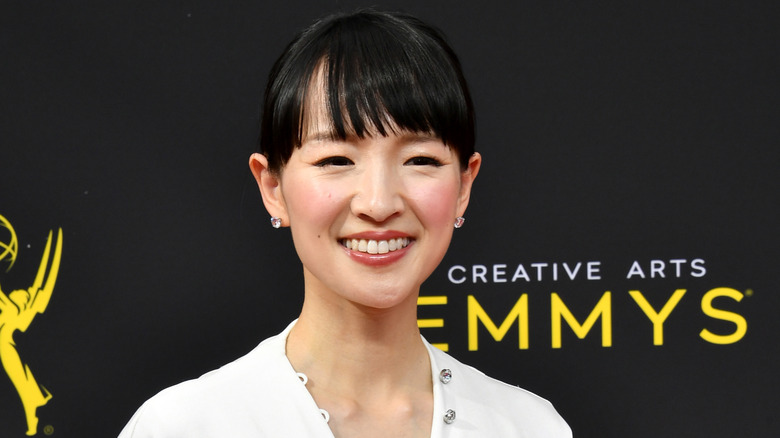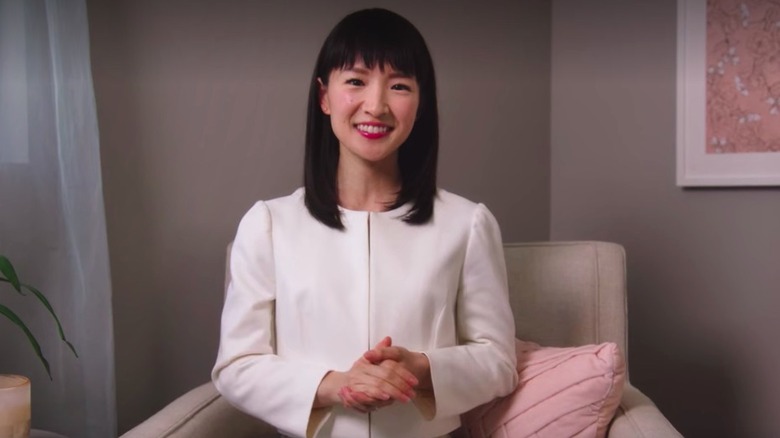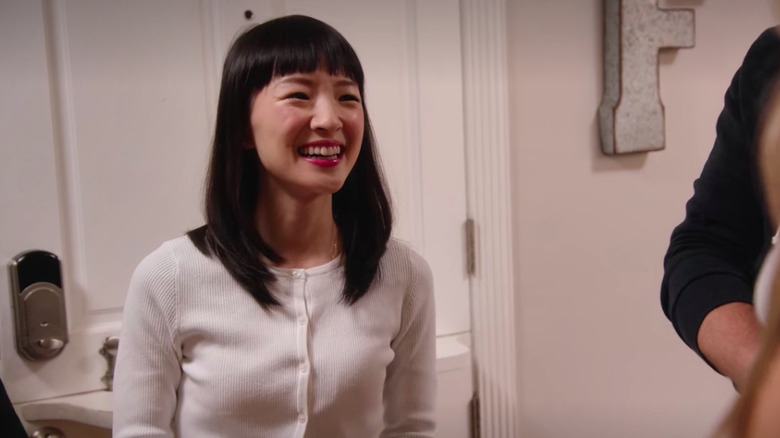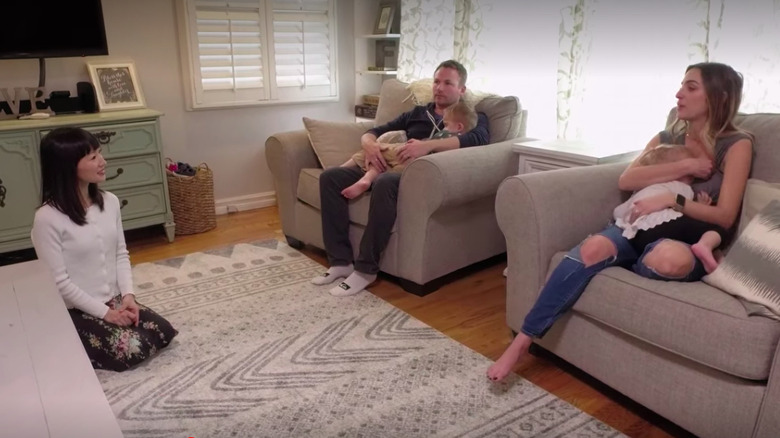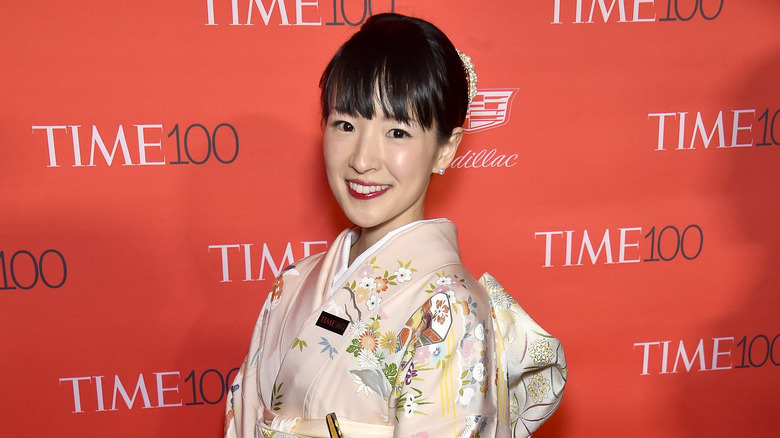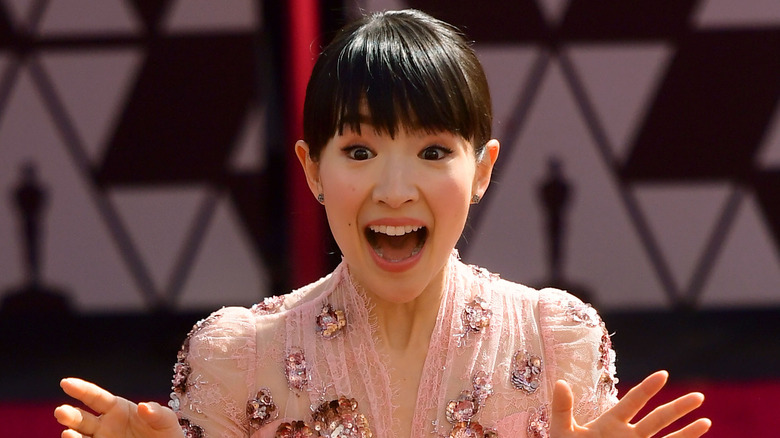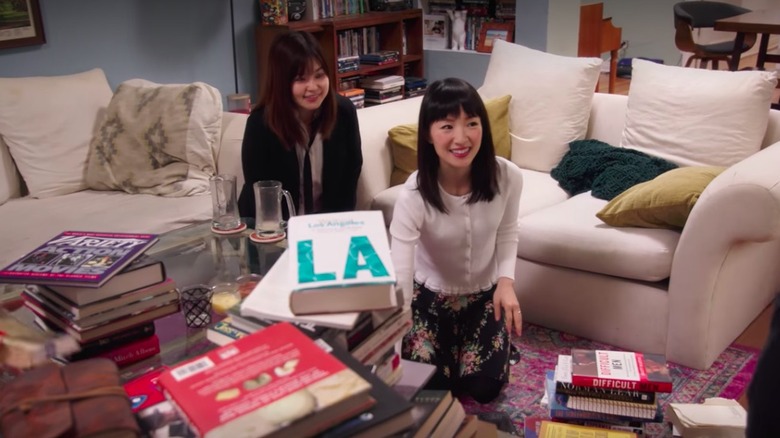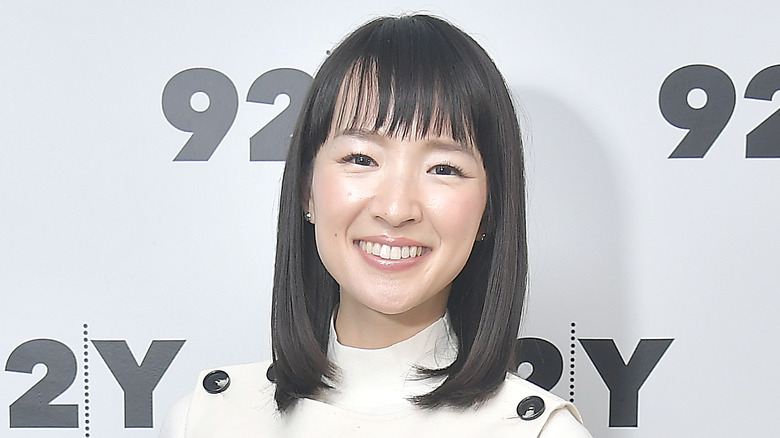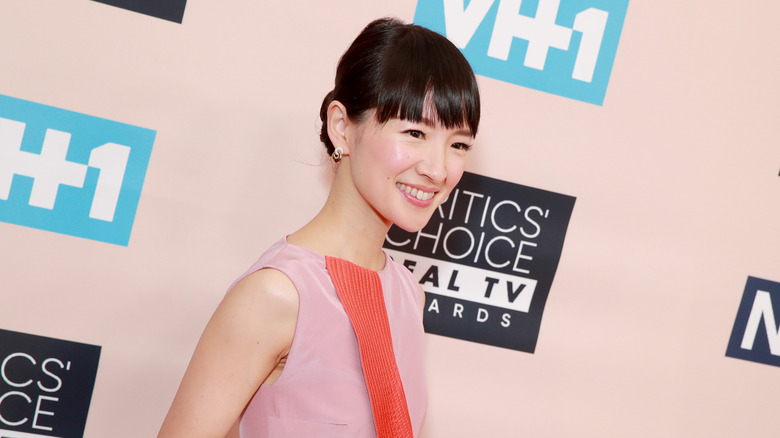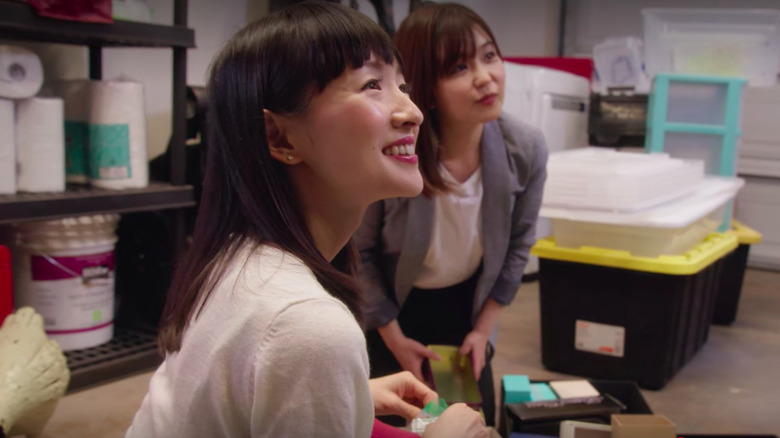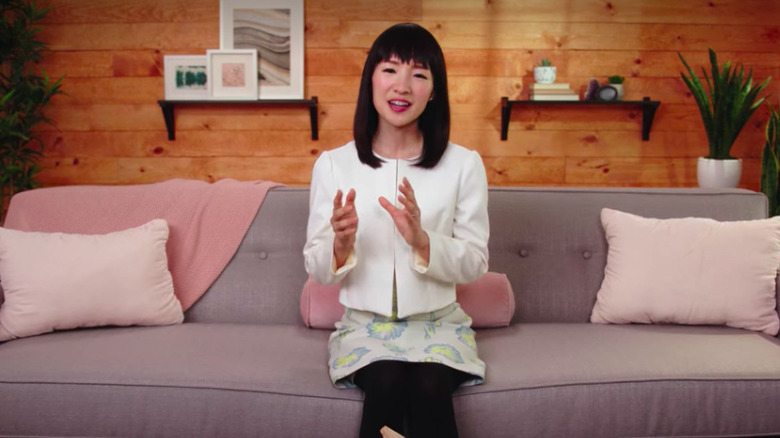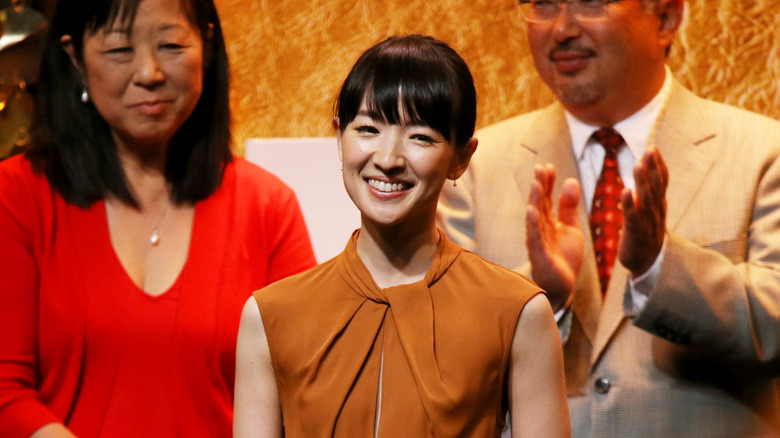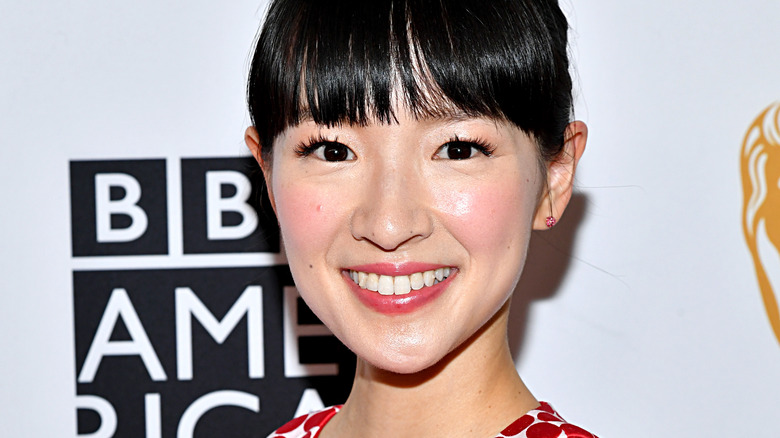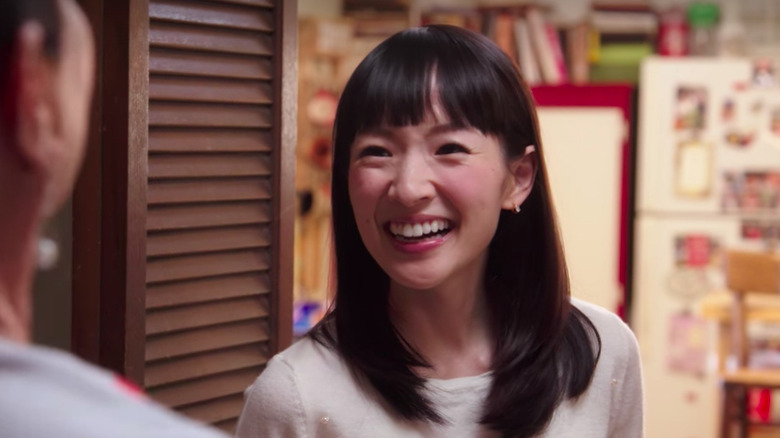Marie Kondo: False Things You Can Stop Believing About Her
Marie Kondo, a tidying expert and New York Times best-selling author, has inspired millions of people worldwide to clean up their lives in more ways than one with her trademarked KonMari Method of organization. Her mission, as she states in the Netflix trailer for her popular show Tidying Up with Marie Kondo, is "to spark joy in the world through tidying" with her method's six basic rules.
Since her Netflix series premiered in January 2019, Marie Kondo, who was named one of Time magazine's 100 Most Influential People in 2015, was credited with the surge of donations to thrift stores after the organizational expert's Netflix show debut (via NPR), as she'd encouraged viewers to clean out their closets. However, since the show premiered, there have been many mistaken ideas about Kondo and her tidying method. Read on for a list of false things you can stop believing about Marie Kondo.
Marie Kondo's Netflix show, Tidying Up with Marie Kondo, jumpstarted her career
Though Marie Kondo found success in the United States with her Netflix series, her career actually started when she was just 19 years old as a popular tidying consultant in Japan. In fact, she became so popular that she eventually had a client wait list that spanned for months. It was then that she decided to write her first book, The Life-Changing Magic of Tidying Up: The Japanese Art of Decluttering and Organizing, which became a New York Times bestseller. "I had accumulated a significant waitlist and decided to write the book so that more people could learn to tidy using my method," she told Variety.
Her initial intention was for everyone in Japan to have access to her KonMari Method, which she developed when she was only in high school, but little did she know the worldwide demand that her tidying business would quickly begin to secure. The stress of a mess seems to be a truly universal dilemma. Kondo told HelloGiggles, "The issues people encounter through tidying are the same — no matter where you live."
Marie Kondo hates clutter
It's assumed that someone who has dedicated her life to keeping people's homes organized would have nightmares about clutter. However, Marie Kondo told Cosmopolitan, "I love mess." Watch any episode of her successful Netflix series, and viewers will see pure joy spread across her face as Kondo steps into some of the messiest spaces. In those moments, she sees her passion for tidying completely transform someone's life, and that brings her joy. After all, Kondo's philosophy is all about keeping items that "spark joy" in their owner.
Kondo suggests beginning the organization process by first taking everything out of the closet, off the shelf, or out of whichever space is being tidied up. "By making this big pile of clothes or what have you, on the bed or on the floor, it's only when you do that you become aware of exactly how much you possess," she told Access Live. She also suggests organizing your home category by category, not room by room, because most people scatter things around their home. "Most people have three times the amount of things they think they do," she added.
Marie Kondo enjoys showing off her organized home
After seeing some of the extremely detailed ways that Marie Kondo suggests folding clothes or organizing a sock drawer, it would make anyone completely fascinated to see it firsthand in her own house. However, according to Newsweek, Kondo has never let a reporter into her home as of this writing. Though the famous tidying consultant's face is on Netflix and her name is plastered across bestsellers, she enjoys privacy with her husband and two small children, who, she told CBC Radio, spark the most joy for her.
"After the release of the Netflix show, there have been more and more people who come up to me on the street, so I myself am just realizing the power of the visual media," she added. Even though the series propelled her fame even further, Kondo says that she still believes she lives a very simple life, focusing on the things that are important to her, just like the renowned KonMari Method she developed guides others to do.
If you hire Marie Kondo, she will come in and tidy your home
Hiring a professional tidying consultant seems like the best way to go for someone whose idea of a fun Sunday afternoon isn't reorganizing the house. However, when you hire Marie Kondo, she's not the one who will be doing the tidying. She will teach the client her KonMari Method and guide them through the six basic rules, but it's up to the client to implement these rules so they become familiar enough to use them in their day-to-day life. "The KonMari Method isn't meant to make your home tidy for a short amount of time," she told HelloGiggles.
With that being said, it's important to designate a space in the home for each belonging. A lot of people don't. "While your house may look organized on the surface, if you have even one item that you don't have a designated location for, you'll see that the item will sort of migrate all over your house, and that will attract clutter," she told Wisdom 2.0.
A cluttered house creates a cluttered mind. She told Access Live, "Tidying has the ability to change, transform your life."
Marie Kondo grew up in a tidy house
A lot of times, famous people in interviews pin their life's passion down to something that inspired them when they were a kid. In Marie Kondo's case, it might be assumed that her love for organization stemmed from the tidiness of her childhood home, but this wasn't exactly the case.
When Marie Kondo was young, there were no windows in her bedroom, so she would cut out photos from magazines and tape them up on her walls as inspiration, visualizing the type of environment she dreamed of eventually living in (via The Guardian). She told Wisdom 2.0, "What's important for the KonMari Method is to identify which kind of state of environment makes you the most happy, the most creative."
Kondo's method translates into tidying up in order to surround oneself with only the things that are important to them. She told HelloGiggles, "Tidying for yourself is essential to hone your sensitivity to joy and decision-making skills. By doing so, you will understand what is important in your life."
Marie Kondo only wants you to keep items that spark joy
The approach to Marie Kondo's method is to tidy up by only keeping belongings that "spark joy" to their owner. "The idea is that you tidy by having a confrontation with each item that you own," she told CBC Radio. Of course, there are lots of items people have to keep in their homes that don't necessarily make them happy. They may be a cabinet of cleaning supplies, the winter coat that warns of colder weather coming, or a briefcase that is a stressful reminder of a disliked occupation. Kondo doesn't want people to throw these necessary items out. Instead, she challenges clients to think about them in a different way.
When Hasan Minhaj, another Netflix personality, requested Kondo's help in tidying up his daughter's nursery, he said that, although necessary, the baby monitor was one item that stressed him out as he worked in the other room. Her reply was, "But does this spark joy for you knowing that you can work peacefully and that your child is safe?"
She told CBC Radio, "Always think about choosing a path that sparks joy for you."
Marie Kondo wants you to throw out your books
A rule that allegedly stemmed from Marie Kondo's Netflix series was that a person should only keep a maximum of 30 books in order to tidy up the shelves in their home. Many people became instantly angered upon hearing this rule and went on social media to express their outrage.
When IndieWire asked Kondo what she thought of all this, she replied with, "The question you should be asking is what do you think about books. If the image of someone getting rid of books or having only a few books makes you angry, that should tell you how passionate you are about books, what's clearly important in your life." She believes if books "spark joy" for a person, then they should absolutely keep them! The main idea of the KonMari Method is to surround yourself with items that make you happy.
Kondo's so-called 30-book rule can be boiled down to a line she had previously expressed to a client: "If the book inspires you, keep it. If not, it goes out" (via The Cut).
Marie Kondo follows all her rules
The essentials behind the KonMari Method can be boiled down to six basic rules: "commit yourself to tidying up," "imagine your ideal lifestyle," "finish discarding first," "tidy by category, not by location," "follow the right order," and "ask yourself if it sparks joy" (via the KonMari website). There are only six of them, but the idea of perfectly following each rule in order to declutter an entire house can carry quite a heavy load for the average person. At the end of a long work day, tidying up your home can seem impossible. In fact, some days Marie Kondo doesn't even follow her own rules.
She laughed as she told The Guardian of her worst habit: "I love wearing slippers, but I take them off in random places around the house — I can't keep them on for long, so they're scattered."
Her method of tidying isn't similar to a yearly spring cleaning. Instead, it's something people have to invest in and be dedicated to daily, but Kondo's still only human like the rest of us.
Marie Kondo's house is always tidy
Maintaining a clean household with children seems impossible, and Marie Kondo knows this well. After the birth of her second daughter, Kondo posted to Instagram about how motherhood changed her perceptions of organization. "I've let go of whatever standard of perfection I used to hold myself and others to," she wrote. "I still regularly tidy and clean and teach my daughters those skills, too, to the best of my ability. But in terms of worrying about the small things, I've no longer the time or energy to pay them mind, and I've accepted that!"
To teach children to tidy up, Kondo told The Washington Post to create a reward. For example, after dinner, "say, 'Okay, now it's tidy-up time, and when we're all done, we're going to have dessert!'"
Kondo hopes her children will develop the same passion she has for tidying, but she also told Time, "After giving birth, I realized I'd been living my life thinking about what sparks joy for me. Now I'm thinking about what sparks joy for my child, for my family."
Marie Kondo wants people to focus on throwing things away
Naturally, when cleaning up the house, people think they have to clean out the house. "A lot of people hit a roadblock because they feel they have to throw something away, but that's not the point," Marie Kondo told The Guardian. Sure, the KonMari Method includes discarding items that no longer "spark joy," but Kondo says that's not the main idea.
She told CBC Radio, "My method rather focuses not on what we discard ... but rather on what we want to retain, what we want to keep in life. By doing so, by making these decisions, it helps you figure out your values in life." Kondo wants her clients to remain focused on what they want to keep because those items are a direct reflection of what they want to surround themselves with in life overall. As she wrote in her first best-selling tidying book, "keep only things that speak to your heart." She noted, "As a result, you can see quite clearly what you need in life and what you don't, and what you should and shouldn't do."
Marie Kondo never regrets throwing things out that don't "spark joy" for her
To figure out if an item "sparks joy," Marie Kondo always suggests physically touching it. "Sometimes you will experience impulsive, fleeting joy when you encounter an item; other times it's more of an enduring, lifetime joy. Both serve a purpose. The important thing is to be aware of the difference," she told Man Repeller. Over time, a person will get better at being able to decipher which items are important to them and, in turn, clearly recognize which belongings are necessary for them to keep long-term.
However, when asked if Kondo herself has regretted discarding anything, what came to her mind was a pair of small kitchen scissors she used to own. "Now that my children are getting older, I sometimes think those scissors would come in handy and be much easier to use than a knife! The lesson here is that if you're not sure how an item is supposed to function, it's important to research it first before letting it go," she added. People shouldn't force themselves to get rid of items they are not ready to!
Marie Kondo only supports a minimalist lifestyle
Clearing off shelves to make them look pretty and ridding the house of clutter may seem synonymous with the term minimalism, a design trend that is quickly taking shape in the United States. However, Marie Kondo told Man Repeller it's important to keep in mind that everyone's idea of what kind of space gives them joy is different. "Minimal living may spark joy for one person, but not for another," she said. "The KonMari Method does not require minimal living." In other words, tidying up does not mean down-sizing.
"The ultimate goal of tidying is to discover how you'd like to live in your home," Kondo added. Every home, just like every person, is completely different. People choose to live their lives in so many different ways, and the things that they surround themselves with in their homes directly reflect this. "Our possessions are directly tied to our sense of identity," Kondo told CBC Radio.
Marie Kondo is upset by criticism to her tidying method
With a single search online, it becomes apparent that the KonMari Method has had a huge impact on millions of people worldwide, but it's not all been in a positive way. Some personal possessions can hold significant meanings to people, and not everyone responds well to being told they need to rid their lives of them. Just turn on TLC's show Hoarding: Buried Alive, and it becomes obvious that there are people in the world who have a terrible time getting rid of things that they own.
Even so, Marie Kondo says there isn't anything wrong with the strong response that her tidying process has been receiving. She told CBC Radio, "This necessarily isn't a bad thing for me because it creates an opportunity for people to understand what they're passionate about. If this message moves you or frustrates you in a certain way, you should be exploring why, and that should allow you to understand what you're passionate about and what you find valuable in life."
The idea behind Marie Kondo's method is all about the organization of your home
The purpose of the KonMari Method is deeper than just tidying up homes. One of Marie Kondo's clients was a publicist at a large fashion magazine who loved her job. However, Kondo told The Guardian, "None of the clothes she had sparked joy — they were all $2,000 jackets from big brands, expensive clothes. She realized her job didn't spark joy and she's now a freelance writer who travels all around the world."
Kondo hopes her Netflix show encourages everyone to take a good look at themselves while following her method. "The focus of the show is not actually tidying, but we want to focus on what kind of transformative experience or changes that it garners in [each clients' life]," she told Wisdom 2.0. By having a person look at their belongings, they are determining what their values are in life.
Kondo told Variety her greatest wish is that people "will develop a greater sense of gratitude for their belongings and that their lives will spark even more joy than before!"
